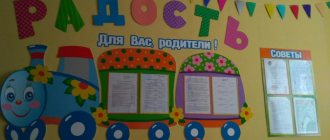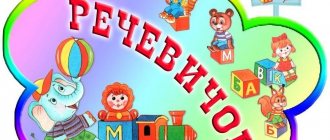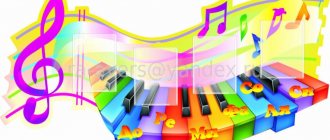Children's center logo
How to create a good logo for a children's center? Which logos look trendy and which ones are perceived as outdated? How much does it cost to create a logo, how to find a designer for this work and how to work with him correctly?
Olga Savelyeva , director of client relations at the BrandVolna branding agency, to tell me about this Its name most likely doesn’t mean anything to you, but there are few families in our country whose homes have not seen designs from this company. Among the main clients of BrandVolna are the international concerns Danone and Reckitt Benckiser, owners of the brands BioBalance, Aktimel, Prostokvashino, Dosia, Tiret, Contex.
The children's theme is close to both the agency and Olga personally. BrandVolna designers have developed a corporate identity for Children's Radio and have been working with baby food brands Malyutka, Malysh, Nutricia, and Tema for many years. And Olga herself has a four-year-old daughter and a two-year-old son, so she has a special relationship with children’s brands - not only as a professional, but also as a mother.
Olga, you and your children often go to children’s centers, theaters, and attend master classes. Surely, with your professional eye, you see some mistakes in the logos of children's companies. Which ones are most common? The first mistake is too many colors. For some reason, it is believed that a children's logo should be multi-colored - they say, the more fun the better. This is partly true: rainbow logos are “native” to the children's theme. However, you need to know the limit in the number of colors, strive for their harmonious combination inside the logo and with the background (the best background for multi-colored logos is white) - otherwise the logo will look heavy, sloppy, not to mention stylish. And instead of fun there will be chaos.
Another common problem: the logo has too many small details, inscriptions, images, and fonts. There is an unspoken law in design - every element must have some meaning, marketing, aesthetic, practical, technical. Check your logo - is it true?
A good way is to test selected logo options on media, i.e. place logo sketches on sign templates, business cards, and on the club wall. This is done using a computer, of course. Although everything that can be printed on paper is worth looking at in actual size.
Or even simpler: open the logo on the computer and move away from it (or simply reduce it to 4-5 cm) - even this simple method helps to assess possible problems.
What else? Unreadability. In search of a creative solution, logos that are interesting in thought but weak in execution are sometimes created. When we look at the logo in the size of a computer screen, it is, of course, readable. Especially if we know what is written there :) In reality, everything may look completely different. You can check readability in the way that I have already described. Although in general this is the task of a good designer.
Maybe then you can tell me the theory in a nutshell? What are the basic rules for creating a logo?
The logo should reflect the concept of your business, be easy to read and remember. Of course, the logo must be original, that is, have individual features.
This is in general. Logos are very different, as they depend on the field of activity and the target audience. You can find a successful exception to any rule.
Ideally, a logo is the main identifier, but not the only one. It is better to immediately focus on creating the entire corporate identity - that is, along with developing a logo, you need to immediately determine corporate colors, fonts and graphic elements, and also understand how the logo will live in a real environment, and not on a white sheet.
For example, you have the “Romashka” club. The logo (word) is green and has an image of a chamomile. Obviously, the daisy is your signature graphic element, and white, yellow and green are your signature color scheme. This does not mean that from now on there should only be chamomile everywhere. For example, other elements that match the style may appear - for example, butterflies. But they must be made in the same style as the chamomile and be in harmony with it in color.
What does corporate identity mean in practice? The style and plot of the logo should be visible in all media - in interior design, in printed materials (business cards, leaflets, advertisements and posters), on the website, banners, etc.
There are often cases when the logo is made in one style, the room is designed in another, the website in a third, and printed materials are generally different each time.
Yes, yes, a very familiar situation. This happens to me too .
This is not a disaster for a small local business, but the unity of style immediately takes you to another level!
Firstly, to better remember the logo itself, secondly, it is easier to identify you outside the walls of the club - for example, on the Internet, in street advertising, during some promotions or events, thirdly, it adds seriousness and reliability to your business , thoughtfulness and even manufacturability.
What types of logos are there?
Structurally, there are three types of logos. The first type is the branded spelling of the word, in a branded font or combination of fonts. For example, lamoda.
The second type is a word with a graphic symbol (with a picture), like in “Children’s World”.
There are logos that have become so famous and even iconic that they often use only a sign to identify them - for example, the Apple apple, the Nike swoosh.
The third type is a logo with built-in graphic elements.
I remember once hearing you say, “This logo is old-fashioned.” What are the current trends in logos? What's in fashion and what's going out of fashion?
Trends depend on the area. A restaurant is one thing, a fashion startup is another, an oil company is another. But there are general trends: modern corporate styles strive for simplicity and purity. Modern people have to deal with a huge amount of information; they need simple and quick influence.
Serif fonts, numerous lines, strokes, shadows, sharp corners, closed forms are most often perceived as classic, traditional. The logos of “Kroshki-potatoes” and “World of Leather and Fur” are no longer perceived as modern and fashionable.
In some cases, designers deliberately use these "old fashioned" techniques to create a vintage look or a brand image with a long history.
And modern logos are characterized by open shapes - the logo is not enclosed in a closed or limited shape, for example, in a circle, oval, rectangle. Such logos have a minimum of additional lines, shadows, and gradients; fonts - straight or playful, conceptual, a la handwritten. They are characterized by thoughtful minimalism - as in the logos of Pampers, Perekrestok, CoralTravel, McCafe.
What are the specifics of children's logos?
In my opinion, in the logo for a children's club, you should especially try to correspond to modern mass trends, so as not to evoke associations with the past, Soviet, etc. in potential clients. This is an area where parents expect the best, modern (but understandable!)
According to research, most mothers want to see appropriate images in children's logos - characters, toys, some cheerful children's symbols - they evoke positive emotions, not to mention the fact that they immediately clearly define the field of activity.
This also helps to build relationships between the child and the club - a significant portion of young clients are already at the age when they can independently perceive images.
A children's logo should be 100% positive, without additional meanings. And it is very desirable - uncomplicated, does not require very deep thought.
Children’s logos, perhaps more than any other, “suit” bright and pure colors, simple, “talking” images, and laconic graphics. The logo can be made childish even without using graphic images - by choosing the appropriate font and color scheme.
The specificity of the children's club logo is the mandatory presence of street communications, i.e. signs. A mandatory requirement for the logo in this case is that it should look good and be readable on the sign from afar. I recommend adding the signature “children’s club/center”, etc. to the logo.
Could you give examples of what you think are successful children's logos?
There may be no perfect logo, but here are some interesting examples of children's logos that I came across online.
For example, a logo for a mini-club in a hotel. The idea is conveyed succinctly and clearly - children's games in the sand. Interesting symmetrical images were invented. A minimum of colors, blue as a neat accent. Reads very well even in the smallest size. Open.
Child drama workshops - logo for a children's theater center. It may not be ideal, but I found it interesting as an example. For all its complexity (but the specificity of the theater allows it, in my opinion), it is obvious that the creators sought to maintain a balance. All the letters in the words are multi-colored, but there is a white background, a simple font and a graphic symbol in the style of a shadow theater. The symbol itself - a child reaching for the stars - is very emotional, even touching. At the same time, there is balance again - there are no details, only the outline.
Heimoose children's clothing logo. Here I liked how the creators rhymed the font style and the style in which the character was drawn, and also played with the name with different colors. The logo looks very solid, is perfectly readable, and is easy to remember thanks to its funny image (a moose with prominent antlers - you want to smile). For our eyes it is somewhat gloomy, of course, I don’t encourage you to go black :)
I also found several good logos of Russian children's clubs: Kid's club from the city of Salavat, Mini Bambini from Novokuybyshevsk, Jolly Polly from Moscow.
By the way, the use of the Latin alphabet is easily explained from a design point of view - there is an incomparably larger selection of interesting gaming fonts. In addition, many perceive Latin letters as immediately denoting something more “premium” and modern.
How to approach creating your logo?
The name of the future club already largely determines the direction and possible graphic symbols. First, you need to decide what exactly you like - what colors, what characters, objects, what designs, etc. Let's go to the Internet for inspiration. It is very convenient to collect information on Pinterest (this is a social network where users collect pictures found on the Internet by topic). By searching “logo”, “kids logo” you can find interesting ideas.
They often try to find logos specifically for their field of activity - this is not necessary. Search more broadly - in children's and family topics, not only in services, but also in goods, not only in Russian, but also in English. And in general, look for any interesting logos, regardless of the field.
Be sure to collect information about your competitors, try to understand how to be different from them, what you like and don’t like.
First, collect everything that seemed interesting from some point of view, then arrange elimination circles until a selection of finds that are truly valuable to you remains.
Nowadays there are a considerable number of template logos on the Internet - for the same query “kids logo” on Google you can find a lot of options for ready-made logos, you just need to buy a template and substitute your name.
If you plan to work with a contractor, then draw up a detailed task, attach so-called “references” - i.e. logos that you like, which should serve as a model, a guide for the designer. You can also attach examples “by contradiction” - how not to do it. But be careful not to end up with simple plagiarism.
How much does it cost to create a logo?
The market for design services is very wide and diverse - both agencies and design studios, as well as freelance designers of various levels, offer their services. The choice depends on your budget and your business goals. The larger they are, the more I recommend choosing agencies as partners. The cost of logo development can vary greatly - a student designer will draw something for 3-5 thousand, and a good mid-level agency will estimate logo development services at 80-90 thousand or more. The difference, as a rule, is in the quality of work and quality of service, in reliability. Although there are both weak agencies and strong freelancers.
What should you pay attention to when choosing a designer or company that will develop a logo?
Firstly, on the portfolio. Everything is simple here – the choice is at the “like or dislike” level. But also pay attention to the reality of the works presented. Were all of them (most of them) accepted and implemented by customers? Sometimes portfolios are filled with sketches and concepts that have never been used anywhere. This is important from the point of view of the contractor's ability to complete the work.
In the case of freelancers, carefully look at the portfolio and choose those whose style you definitely like. An ordinary freelance designer is one person whose resources are limited. Relatively speaking, he draws as best he can. Therefore, his skill should completely suit you.
Pay attention to the quality level of different works. If in one person’s portfolio one logo is wonderful, and the other is complete nonsense, then very often this means that the beautiful one was either made while working in a team (agency, design studio, etc.), or copied from somewhere, and the bad one - the fruit of independent fantasies. And it is not at all necessary that it already contains logos of children's clubs or something similar. Professionals are able to work with different tasks.
It is also important to find out what is included in the price, how many first sketches you will receive, how many times you can make comments on the selected option, what will happen if you don’t like any of the first sketches, how many times you will (and whether) be provided with new ones, whether terms of work for cost.
Many freelancers and agencies in the economy segment have a “Rule of Three”: for a fixed price, they provide three initial sketches and then make corrections and wishes to the selected one no more than three times (there are other conditions). More professional agencies often work “until the bitter end.”
Even at the dating stage, pay attention to how the contractor communicates with you. How quickly, efficiently and patiently does it respond to requests? What questions does he ask himself? Professional agencies will definitely ask you questions about your business strategy, target audience, competitors, tasks, ask you to talk about the market, and sometimes they themselves will share their knowledge. Ease of communication is one of the keys to success. If communication does not work out, then refuse such a contractor, even if he has interesting work in his portfolio and the price suits you.
The ideal contractor listens to you, strives to meet your wishes, but at the same time makes sure to offer his professional vision, makes recommendations, and does not just draw pictures.
How to work with a contractor, what do you need to know about the timing and procedure of interaction?
It is very important to create a brief for any contractor. In addition to examples of logos that you like, describe the specifics of your project, formulate the positioning, at least with a set of keywords.
What should your future logo say to potential clients? Is your center fun? Informative? With care? Status? Etc. Perhaps you will say that all this is true. But for positioning and creating a logo, you need to select the most important, two or three characteristics. This is necessary not only for the contractor, but also for you.
Without these ideas, without understanding “what I am and what I want,” the result is often disappointing, “everything is not right.” Unfortunately, I know many examples when companies cannot approve a logo for months and sometimes even years (!), going through agencies and designers, wasting resources and time.
Don't forget to inform the contractor about technical limitations, if any (especially regarding signage).
And it’s worth agreeing on three deadlines right away. The first is the date of submission of the first sketches, usually no more than two weeks from the start of work. The second deadline is how long it will take for the designer to finalize the selected options based on your comments. And the third is the final deadline, i.e. no later than when you need the finished result.
This is not always done, but it would still be useful to have a copyright agreement, in which the designer guarantees the originality of the work and transfers copyright.
Olga, thank you very much!
What about your logo? How did you come up with it and create it? Are you happy with it? Share your experience in the comments.
A short guide “How to open a children's club?”
What should you pay attention to when choosing?
Color
When creating your daycare logo, look for colors that reflect the mood and message you would like to convey.
The designer will offer you ready-made color solutions to make it easier for you to find what you want, but you can edit the colors of your logo at any step.
When creating your palette, try to limit yourself to one or two colors.
Form
Will your kindergarten have a website?
Will you print your logo on the clothes of teachers and staff?
The best logo shape for your brand is the one that suits the media you will be using your logo on most often, whether physical or digital, large or small.
Luckily, our service will show you how your logo will look in different places and on different surfaces before you buy it.
Font
Pay attention to choosing the right font for your brand name.
Typography, like color, can convey the mood and message of your audience.
Don't be lazy and test several different fonts, look at as many options as you need to find the right one.
As we said earlier, kindergartens most often use playful fonts with rounded edges, as if the child had drawn the name by hand.
Symbol, icon
Yes, you will definitely use a symbol associated with children in the logo of your kindergarten, but icons are also different.
The designer will present hundreds of different icons ideal for preschool institutions, so select several at once and compare them together, adding your favorite logo options to your favorites.
Creating and editing your logo is absolutely free. Buy ready-made files only if you are satisfied with the design. Create a logo online.
Children are the main owners of libraries
In children's libraries, of course, the main visitors are children. Their time within the walls of this institution can be turned into an interesting and spectacular event. Some libraries organize small improvised theatrical stages with weekly screenings of short tales, plays, or presentations of new products and arrivals that are the most interesting and necessary.
How to design a children's corner in the library? There is no general order, and this is perhaps a plus, because there is room for imagination and creativity. However, most often they organize a corner for emotional and rational reading. The emotional zone includes the most interesting books; the child can immediately read and choose a book for home reading. The rational reading corner cannot do without publications included in the school curriculum; these also include additional literature for in-depth study of school subjects.
In the photo you see an option on how to arrange a children's corner in a children's library.
Multi-level order
The multi-level model of children's libraries is especially in demand. When the reading space is organized according to the following principles:
- availability of books;
- visibility of decorated stands and corners;
- an original organized space to ensure information content and interest.
For each age group of the children's corner in the children's library, a specific zone is allocated, but without “hard boundaries” so that the reader can freely change levels if he wants.
At the same time, educational excursions to libraries are recommended for the little ones. During them, readers are shown how a library card is issued, how books are issued, how long it takes to read them, and when and in what form they need to be returned.
Libraries, designed to accommodate different reading interests, are always full of visitors. In the photo you see an example of successful zoning, which allows not only children, but also adults to have an interesting time in the children's library.










